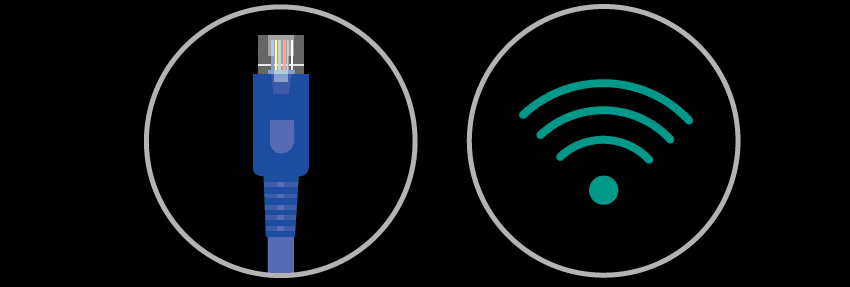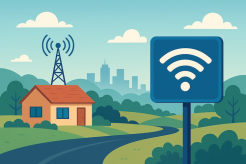Is It Really Better to Go Wireless or Stay Ethernet for your internet?

Decide whether you stick to Ethernet or go wireless for your application to get the best internet connection. The selection between wireless and wired internet depends entirely on your needs. Ethernet is your best bet if you want low latency and consistent speed. Wi-Fi is the best option for convenience and minimal clutter.
Related
The Best Unlimited Wireless Internet for 2022
Ethernet vs. Wi-Fi: Advantages and Disadvantages
To obtain the best latency when playing Call of Duty or Apex Legends with your buddies, you'll need an Ethernet connection. Wi-Fi, on the other hand, is best used when watching Netflix on a tablet while lying in bed. Furthermore, some smart devices do not support Ethernet connections, necessitating the use of Wi-Fi.
What are the advantages of Ethernet?
We understand that Ethernet isn't the most appealing option. The main selling point, however, is that it provides consistency and security at the expense of clutter and annoyance. Ethernet is only preferable in certain situations, such as online gaming and streaming movies.
Consistency
Consistency and range are the most important aspects of Ethernet. Unlike Wi-Fi connections, wired transmissions do not vary. Data flow is unbroken from beginning to end, with only your internet plan and network congestion outside your home acting as bottlenecks.
Routers, on the other hand, transmit internet connections across a limited range. Your connection is entirely dependent on the router's generation, the number of antennae it has, the number of antennas within your wireless device, the generation it supports, and the number of wirelessly connected devices.
The newer Category 7 cables can deliver a continuous maximum transmission speed of 10 Gbps over 328 feet when used with Ethernet. Home networking devices such as modems, routers, and unmanaged switch boxes, on the other hand, typically limit the speed to 1 Gbps because most internet subscriptions don't go above that.
Simplicity
Connect your Ethernet wire to your modem or router on one end and your device on the other. There's no need to manually connect to the network and type in the password. Furthermore, troubleshooting connectivity issues is easier—all you have to do is a reboot or change the cable.
Mobile devices, on the other hand, lack Ethernet (RJ45) connectors, necessitating the use of a USB adaptor.
Security
Ethernet provides a direct physical connection with the internet. As with Wi-Fi, there's no risk of a hacker eavesdropping on your connection and intercepting your emails or financial information. Ethernet connections aren't completely secure. Although a hacker may physically connect to the network and launch malware, the chances of this happening are slim to none.
Reduced latency
This is connected to Ethernet's steady speed. Latency is the time it takes for data to leave your device, travel to its destination, and then return to you. In gaming, you want the round trip to take as little time as possible, and Ethernet excels at this.
Due to the location of your device, the number of other wireless devices currently accessing the network, interference from neighboring networks, and interference from other wireless devices, latency is higher while using Wi-Fi. Even on the 5 GHz band, Wi-Fi cannot guarantee a steady data throughput. It's possible that you'll lose the signal totally.
What are the advantages of using Wi-Fi?
While most devices can connect to the internet over Ethernet, bulky adapters and extensive cables may be inconvenient. Wi-Fi eliminates the need for clutter and is just more convenient.
Compatibility and practicality
When it comes to compatibility, Wi-Fi takes the lead over Ethernet. Wireless connectivity is now standard on most computing devices. Desktops, laptops, game consoles, mobile devices, Internet of Things (IoT) devices, set-top boxes, and other similar devices are included. You can even have a wirelessly connected stove, microwave, refrigerator, and other appliances.
Ethernet, on the other hand, isn't quite as compatible. To physically attach your device to a network, requires a dedicated RJ45 socket. With the exception of the Nintendo Switch dock, which can be upgraded to have Ethernet connectivity by purchasing a USB-based adapter, most desktops and gaming consoles come with an Ethernet connector.
A big Ethernet port makes no sense on smartphones, tablets, or thin-and-light computers. A USB adapter can be used to add Ethernet (RJ45) connectivity. Sure, they're huge and inconvenient, but if you're ready to give up mobility in exchange for bandwidth, they can be surprisingly affordable.
Connectivity on a large scale
Because there are no physical connections, a router can be accessed by 50 or more wireless devices at the same time. If you need to connect more Ethernet-based devices than the four allowed by the router, you'll need to install gigabit Ethernet switch boxes.
Consider one of the quickest routers for gigabit internet to manage all of your wireless traffic.
Less clutter
There are no cables or switch boxes with Wi-Fi, therefore there is no clutter.
Ethernet may transform your home into an electrical jungle, with "vines" draping down from equipment and "snakes" snaking along the baseboards. Switch boxes may be used to expand your wired network to handle more devices than your router or modem was designed to support in some instances.
Installing flat Ethernet wires, especially if they're running down baseboards and around door frames, is one approach to help ease all the ugliness. They are less visible than the old-school spherical cables since they sit flat against the wall.
Also, Read: How to Send Large Files Over the Internet?
Related Posts

Fri, Dec 12, 2025 3:17 AM
Internet BundlesHow to Get the Best Value From Your Internet Plan
Learn how to save money on your internet bill by optimizing your plan, upgrading smartly, and choosing the right speed and equipment for your home.

Thu, Dec 11, 2025 2:25 AM
Broadband DealsBest Broadband Service in the US: Guide to Fast, Reliable Internet
Discover the best broadband service in the US. Compare top providers like Google Fiber, AT&T, Verizon Fios, Xfinity, Spectrum, and more to find fast, reliable internet for your home or business.

Wed, Dec 10, 2025 1:16 AM
Internet BundlesSeniors’ Guide to the Best Streaming Bundles
Discover the best streaming bundles for seniors. Learn which streaming services, apps, and internet plans make entertainment easy and affordable.

Tue, Dec 9, 2025 2:32 AM
Internet BundlesIs Your ISP Throttling Your Internet? Here’s How to Tell
This explains the signs, testing methods, and solutions to prevent speed slowdowns and maintain consistent performance.

Mon, Dec 8, 2025 5:48 AM
Internet BundlesSmarter Ways to Get Internet Without a Phone Line or Cable TV
Learn the best ways to get internet without cable TV or a phone line. Explore DSL, fiber, satellite, and fixed wireless options with a simple, natural guide for today’s cord-cutting households.
